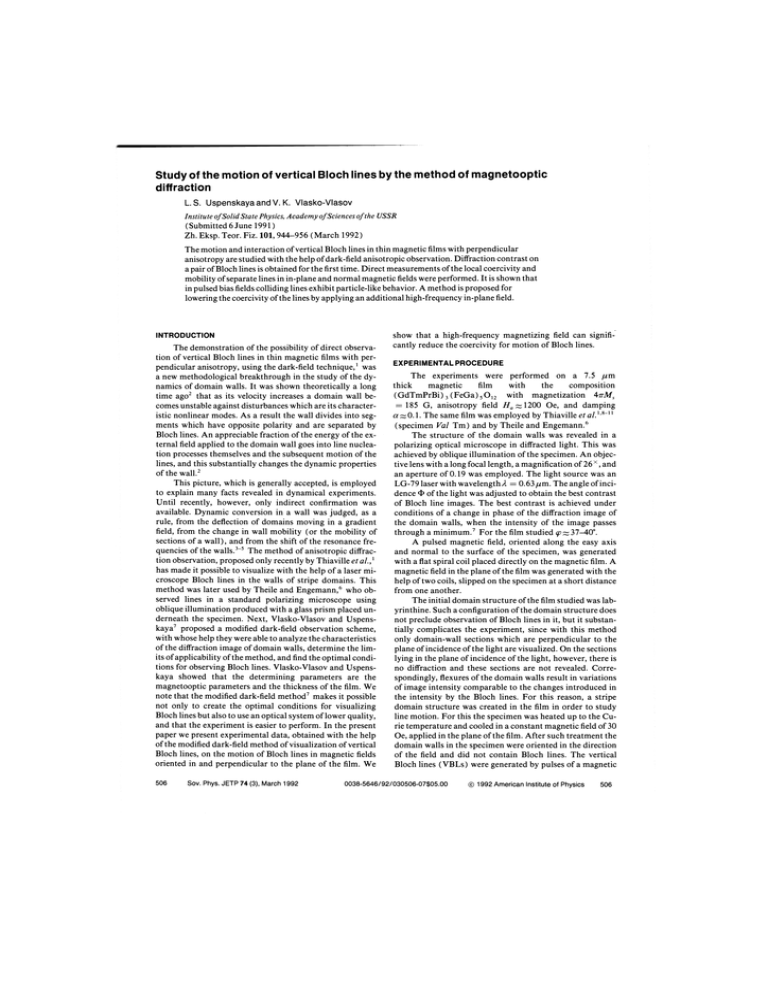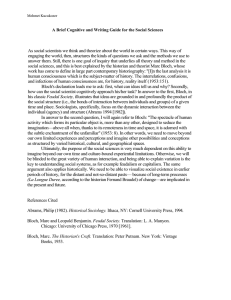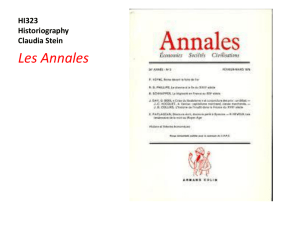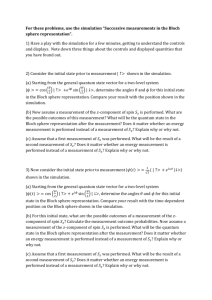Study of the motion of vertical Bloch lines by the method of
advertisement

Study of the motion of vertical Bloch lines by the method of magnetooptic diffraction L. S. Uspenskayaand V. K. Vlasko-Vlasov Institute of Solid State Physics, Academy of Sciences of the USSR (Submitted 6 June 1991) Zh. Eksp. Teor. Fiz. 101,944-956 (March 1992) The motion and interaction of vertical Bloch lines in thin magnetic films with perpendicular anisotropy are studied with the help of dark-field anisotropic observation. Diffraction contrast on a pair of Bloch lines is obtained for the first time. Direct measurements of the local coercivity and mobility of separate lines in in-plane and normal magnetic fields were performed. It is shown that in pulsed bias fields colliding lines exhibit particle-like behavior. A method is proposed for lowering the coercivity of the lines by applying an additional high-frequency in-plane field. INTRODUCTION demonstration of the possibility of direct observation of vertical Bloch lines in thin magnetic films with perpendicular anisotropy, using the dark-field technique,' was a new methodological breakthrough in the study of the dynamics of domain walls. It was shown theoretically a long time ago2 that as its velocity increases a domain wall becomes unstable against disturbances which are its characteristic nonlinear modes. As a result the wall divides into segments which have opposite polarity and are separated by Bloch lines. An appreciable fraction of the energy of the external field applied to the domain wall goes into line nucleation processes themselves and the subsequent motion of the lines, and this substantially changes the dynamic properties of the walL2 This picture, which is generally accepted, is employed to explain many facts revealed in dynamical experiments. Until recently, however, only indirect confirmation was available. Dynamic conversion in a wall was judged, as a rule, from the deflection of domains moving in a gradient field, from the change in wall mobility (or the mobility of sections of a wall), and from the shift of the resonance frequencies of the wall^.^-^ The method of anisotropic diffraction observation, proposed only recently by Thiaville et al.,' has made it possible to visualize with the help of a laser microscope Bloch lines in the walls of stripe domains. This method was later used by Theile and Engemann,6 who observed lines in a standard polarizing microscope using oblique illumination produced with a glass prism placed underneath the specimen. Next, Vlasko-Vlasov and Uspenskaya7 proposed a modified dark-field observation scheme, with whose help they were able to analyze the characteristics of the diffraction image of domain walls, determine the limits of applicability of the method, and find the optimal conditions for observing Bloch lines. Vlasko-Vlasov and Uspenskaya showed that the determining parameters are the magnetooptic parameters and the thickness of the film. We note that the modified dark-field method7 makes it possible not only to create the optimal conditions for visualizing Bloch lines but also to use an optical system of lower quality, and that the experiment is easier to perform. In the present paper we present experimental data, obtained with the help of the modified dark-field method of visualization of vertical Bloch lines, on the motion of Bloch lines in magnetic fields oriented in and perpendicular to the plane of the film. We 506 Sov. Phys. JETP 74 (3), March 1992 show that a high-frequency magnetizing field can significantly reduce the coercivity for motion of Bloch lines. EXPERIMENTAL PROCEDURE The experiments were performed on a 7.5 p m thick magnetic film with the composition (GdTmPrBi) (FeGa) O,, with magnetization 4n-M, = 185 G, anisotropy field H, 1200 Oe, and damping a ~ 0 . 1The . same film was employed by Thiaville et al.'.8-" (specimen Val Tm) and by Theile and Engemann.6 The structure of the domain walls was revealed in a polarizing optical microscope in diffracted light. This was achieved by oblique illumination of the specimen. An objective lens with a long focal length, a magnification of 26 X, and an aperture of 0.19 was employed. The light source was an LG-79 laser with wavelengthil = 0.63pm. The angle of incidence Q, of the light was adjusted to obtain the best contrast of Bloch line images. The best contrast is achieved under conditions of a change in phase of the diffraction image of the domain walls, when the intensity of the image passes . ~ the film studied q , 37-40". ~ through a m i n i m ~ m For A pulsed magnetic field, oriented along the easy axis and normal to the surface of the specimen, was generated with a flat spiral coil placed directly on the magnetic film. A magnetic field in the plane of the film was generated with the help of two coils, slipped on the specimen at a short distance from one another. The initial domain structure of the film studied was labyrinthine. Such a configuration of the domain structure does not preclude observation of Bloch lines in it, but it substantially complicates the experiment, since with this method only domain-wall sections which are perpendicular to the plane of incidence of the light are visualized. On the sections lying in the plane of incidence of the light, however, there is no diffraction and these sections are not revealed. Correspondingly, flexures of the domain walls result in variations of image intensity comparable to the changes introduced in the intensity by the Bloch lines. For this reason, a stripe domain structure was created in the film in order to study line motion. For this the specimen was heated up to the Curie temperature and cooled in a constant magnetic field of 30 Oe, applied in the plane of the film. After such treatment the domain walls in the specimen were oriented in the direction of the field and did not contain Bloch lines. The vertical Bloch lines (VBLs) were generated by pulses of a magnetic 0038-5646/92/030506-07$05.00 , -- @ 1992 American Institute of Physics 506 field oriented along the easy magnetization axis. The characteristic widths and magnitudes of the field pulses are presented below. DIFFRACTIONIMAGE OF DOMAIN WALLS Figure 1 shows the diffraction image of a domain wall (negative), observed under a polarizing optical microscope with oblique illumination of the specimen. The significant changes (marked with dashes) in the contrast of the image of the domain walls correspond to Bloch lines in the walls. The darkening of the lines is determined by the a charge of the line, the direction of magnetization in neighboring domains, and the angle between the normal to the domain wall and the wave vector of the light. Such a symmetric interpretation of the image of Bloch lines was proposed in Ref. 8 on the basis of a numerical calculation of the intensity of the diffraction image of a domain wall. In the calculation the domain wall was considered to be a one-dimensional phase edge for polarized light and the vertical Bloch lines were point centers of diffraction. The computational results showed that a region, smaller than or of the order of the width of the domain wall, of local increase or decrease of intensity, depending on the sign of the u charge of the line and the magnetization in the domains, should be observed at the location of a line in the image of the domain wall. This prediction qualitatively describes only the observed darkening of the lines. In the present work, like in Refs. 1 and 6, the correlation between the contrast and the a charge was checked according to the response of the lines to an in-plane field. There are, however, a number of discrepancies between the results of Ref. 8 and experiment. Thus in Ref. 10 Thiaville and Miltat themselves note that the polarization properties of the contrast and the size of the image of lines do not agree with their model. In addition, contrast inversion on the lines with increasing angle of incidence of the light was observed in Ref. 7 and independently in Ref. 9, while according to Ref. 8 contrast inversion should occur only if in the plane of incidence normal to the wall the illuminating beam is turned in the other direction relative to the normal to the specimen. In Ref. 7 the inversion is associated directly with the change in phase of the diffraction image of the wall, determined by the thickness of the film d (this is confirmed by calculation and experiment with thinner specimens). In Ref. 9 Thiaville and Miltat also concluded that the contrast depends on the thickness of the specimens. Here, it is true, they found, from analysis of the observed changes in the intensity of the image accompanying a change in the angle of incidence of the light, that the length of a line is less than d. In Refs. 9 and 10 it is ultimately concluded that deformation of the wall near the line is the main reason for the contrast associated with it and is the main explanation for the greater length of the line image. It seems that together with this the line inclination in the plane of the wall could lead to a significant broadening of the contrast. As one can see from Fig. 1, the domain walls contain, together with the above-studied nonuniformities of their image, a series of less intense nonuniformities. Such nonuniformities were observed in Ref. 10 and were attributed to microdeformations of the domain wall on defects of the magnetic film. Our experiments show that some of these nonuniformities are pairs of Bloch lines while others are indeed determined by disturbances of the structure of the walls on defects or by the diffraction of light on the defects themselves. This question is discussed in greater detail below. MOTION OF BLOCH LINES IN AN IN-PLANE FIELD FIG. 1. Diffraction image of the domain structure of a thin magnetic film (negative) observed with oblique illumination of the specimen (angle of incidence of the light @ = 38", and aperture of the microscope objective 0.19). The dashes mark the position of the Bloch lines. The illustrations were obtained by printing out separate frames of a video film. 507 Sov. Phys. JETP 74 (3), March 1992 When vertical Bloch lines are present in domain walls in a magnetic field h, oriented along the walls in the plane of the specimen, the magnetic polarity of the walls should reverse as a result of line displacement. Such a displacement is observed when the dc field h, is greater than the coercivity field of the lines. In this case, the lines move in a jump-like fashion along the walls and the magnitude of the displacement is limited by the presence of stoppers in the path of the line. These stoppers are often revealed in the form of bright spots in the image of domain walls when observed in diffracted light, but they are invisible under the standard conditions of observation in transmitted polarized light. The minimum line coercivity h f is equal to about 4 Oe. Pinning on separate defects is so significant, however, that the lines remain pinned right up to fields h f =: 100 Oe. Averaging over many lines gives the value ( h ) zz 6 Oe. The displacement of Bloch lines in the field h, is illusL. S. Uspenskaya and V. K. Vlasko-Vlasov 507 FIG. 2. Displacement of vertical Bloch lines under the action of pulses of an in-plane field h, directed along the domain walls. The dashes mark the successive positions of the lines after the action of the field pulses h,. The last frame shows the merging of lines into a pair. The shape of the field pulses h, is shown in the inset. trated in Fig. 2. A section of the crystal containing four domain walls was photographed (dark-field observation; angle of incidence of light @ =; 38"; negative). Images of the same section of the crystal reveal changes in the structure of the domain walls in the field. The dashes in the figure designate Bloch lines displaced after successive single pulses of the field h, . The lines move steadily in a direction determined by the polarity of the field pulses and by the direction of magnetization in the segments of the domain wall. In accordance with the above-described characteristics of the darkening of vertical Bloch lines, lines with the same contrast move in the same direction, in one and the same domain wall and on all even walls with respect to it, while on neighboring walls lines with the same contrast move in opposite directions. In an inplane field h, lines with opposite contrast on one and the same wall move in the opposite directions. When a pulsed magnetic field h, is applied to the crystal the displacement of the lines increases with increasing pulse width, as shown in Fig. 3. The dots designate the displacements of separate Bloch lines in domain walls located in the field of view of the microscope (250x250 p m ) within one pulse of the field h, of strength 9 Oe. Since the experimental values of the displacements are virtually identical for some lines, the same symbol is used for them in the figure. - 508 Sov. Phys. JETP 74 (3), March 1992 The light circles designate the arithmetic mean values of the displacements (taking equal values into account). The spread of the displacements of separate lines is determined by the density of defects in the chosen section of the crystal. Figure 4 shows the experimentally determined dependence of the displacement of Bloch lines on the amplitude of the field pulse h, (the pulse width is r = 0.6 p s at the 0.7 level; in addition, the duration of the leading edge is ~ 0 . ,us 1 and that of the trailing edge is -0.15 p s ) . Once again the dots denote the displacement of separate lines, while the light circles designate their averaged values. The minimum coercive force for line motion in a pulsed field is approximately equal to h in a constant field ( > 4 Oe) and the average value is ( h ) 6 Oe. The line mobility in the field h, can be determined from the data obtained. If the pulse shape is approximated (see inset in Fig. 2) by the expression h = h,sin2(rt / r ) and it is assumed that for h > h the line velocity is proportional to the field, V,, = p,, h and for h < h the line velocity V,, = 0, then the line displacement S,, over the time the field is applied is given by : - : : : L. S. Uspenskaya and V. K. Vlasko-Vlasov 508 FIG. 3. Displacement S of Block lines as a function of the width r of the magnetic-field pulses. The amplitude of the pulses h, = 9 Oe; C d i s placement of separate lines; &average displacement over all lines; the dashed line is the interpolated straight line. Hence we obtain an estimate of the line mobility from the measured values of S ( h ) :p,, z 14.6 m/s-Oe. The theoretical curve described by the formula ( 1) was fit to the experimental data in order to find p,, and h : from the line displacement in fields up to 12 Oe. As the field increases nonlinear effects should be expected to occur; this could be indicated by the deviation of the average line paths from the line path computed for large h, (see Fig. 4 ) . However, it is necessary to take into account the fact that at h, > 12 Oe some lines moving toward one another collapse. This reduces the relative number of long paths, and as a result the average value is less than the value possible for individual lines. In weaker fields the average values are satisfactorily described by the relation ( 1) (dashed curve in Fig. 4). The values h f, z 6 Oe a n d p 10 m/s.Oe were obtained in Ref. 11 for a specimen with a close composition. If the mobility is determined in the field h, from the reduced equations of motion of a wall with a line,2 then neglecting the thinning of the wall on a Bloch line it is found that pil =:r Q '12yA/2a, where Q is the figure of merit of the magnetic film, y is the gyromagnetic ratio, A is the width of the Bloch line, and a is the viscous-damping parameter. For the 3 which is twice the experimenfilm studiedp~,~ 3 m/s.Oe, tal value. This disagreement is apparently related with the coercive relief, which, as shown in Ref. 12, reduces the line mobility. It is also not excluded that this is related with the nonlinearity of the line motion." Unfortunately, it is impossible to analyze the contribution of these factors to the observed experimental spread. Under the action of successive magnetic-field pulses of the same polarity, lines move in the same direction until they approach the lines of opposite contrast, i.e., lines whose u charge has the opposite sign. Next, either annihilation of two -- 509 Sov. Phys. JETP 74 (3),March 1992 FIG. 4. Displacement of Bloch lines as a function of the magnitude of the field h, ( T = 0.6 ps); .--displacement of separate lines; w i s p l a c e ment averaged over all lines; the dashed curve was calculated with the help of the formula ( 1 ). approaching lines is observed or a cluster of line pairs is formed (in Fig. 2e the lines forming a pair are marked with a square). These two variants of the interaction are evidently determined by the signs of the r charges of the converging lines, and the signs cannot be determined solely on the basis of the contrast of the image of the lines. In the first case, in the section of the domain wall where the lines collide and vanish, the intensity of the image of the wall becomes uniform, while in the second case weak variation of contrast (lightening and darkening) is observed at the location where the pair is formed. The brightness of the image of a pair is weaker than the brightness of separate lines and is comparable to the defect-induced changes of the intensity on the domain wall. The length of the image of a pair is several times smaller than the length of the image of the lines before they merge. If a long image corresponds to large inclination of separate lines, as assumed in Ref. 9, then it can be conjectured that the small size of the pair is determined by the orientation of the lines along the normal to the film as the lines merge. It is possible, however, that image narrowing is caused by the interference of the images of separate lines as the lines approach one another. From qualitative considerations it is obvious that when bright and dark spots approach one another their contrast and their visible size should decrease. It appears that the image of a pair of vertical Bloch lines, shown in Fig. 2, is the first such image ever obtained. The lines were made visible by optimizing the conditions of observation by adjusting the angle of incidence of the light. We note that the observation of the motion of pairs of vertical Bloch lines was mentioned in Ref. 6, but no corresponding photographs or a description of changes in line contrast were given. Application of additional in-plane pulses with the same L. S. Uspenskaya and V. K. Vlasko-Vlasov 509 polarity at which the pair was formed does not result in appreciable displacement of the pair. At the same time, when the polarity of the magnetic-field pulses is reversed the pair formed decomposes and the lines move apart. In this process the image of the lines once again becomes extended. Motion of a pair as a whole is observed only in a field oriented along the easy magnetization axis; this will be examined in the next section. LINE MOTION IN A PULSED FIELD ORIENTED ALONG THE EASY AXIS In the case of quasistatic magnetization of a specimen by a field oriented along the easy axis, the Bloch lines virtually do not move along the domain wall. They also remain stationary with slow cyclic reversal of the magnetization (at frequencies 10-100 Hz). But under the action of a high-frequency ( > lo3 Hz) or pulsed magnetic field, oriented perpendicular to the plane of the film (h, ), line motion owing to gyrotropic effects is observed. In the experiment, pulses of the field h, with width Tz0.3 p s and a rise time of about 0.1 p s were employed. The lowest pulse amplitude h f with which line motion started was found to be of the order of 10 Oe, and for separate lines the field exceeded 30 Oe. In fields h, higher than h f the Bloch lines, as a rule, move irregularly along the domain walls and are arrested on stoppers. On some sections of the domain walls, however, quite reproducible motion of the Bloch lines is observed. In this case the mobility of the Bloch lines is of the order of 1 m/s.Oe (the line mobility in the experiment was estimated from the formula p CLS /T( h, - h C, ), where Sis the line displacement over the time of the pulse T, h, is the magnitude of the pulse, and h f is the coercivity of the line). In Ref. 1 1 random displacement of separate lines was observed in an analogous specimen in a pulsed field h, above 13 Oe (with rise time < 20 ns), but the line displacements are not presented, which makes it impossible to compare the mobility with the value presented above. The theoretical estimate p,, = n-Q"'yA/2a2z330 m/s.Oe, obtained from the reduced Slonczewski equation,2 for the mobility of lines driven along a rigid wall by a field h,, is more than two orders of magnitude greater than the experimental value. It seems that together with the coercive relief, as in the case of h, ,another reason for the discrepancy could also be the inadequacy of the rigid-wall model. A simplified model of the motion of a vertical Bloch line in a pulsed bias field, taking into account the coercivity of the Bloch lines and the flexure of a domain wall as it moves, was examined in Ref. 14. In accordance with this model, we estimated the line displacement S in the field h,, taking into account the coercivity of the lines h: ~6 Oe and the shape of the field pulse, approximated by the relati~n h, = h,sin2(7it /T). We obtained the value S = 14 pm, which does not depend on the amplitude of the field. A displacement 3-10 p m was observed in the experiment. The agreement obtained is entirely satisfactory. It indicates that the coercivity of the lines and the flexure of the walls play the decisive role for describing the dynamics of vertical Bloch lines. We note that the line motion is significantly less stable in a field h, than in a field h,. Even situations when under the 510 Sov. Phys. JETP 74 (3),March 1992 FIG. 5. Displacement of a separate Bloch line and line pairs formed in the field h,. Images of the same section of the domain wall after successive pulses of the magnetic field were applied are shown. action of successive field pulses having the same polarity the direction of motion of separate lines changed and then the lines once again moved in the previous direction were observed. Since the direction of motion of each line in a field h, is determined by the direction of motion of the domain wall in which the line is located as well as by the signs of the a a n d n. charges of the line, it can be conjectured that this instabiiity can be connected with the change in the structure of the Bloch lines owing to the nucleation and displacement of Bloch points in them. In a field h,, just as in a field h,, as lines with opposite a charge directions approach one another, we have either annihilation of separate lines or formation of bound pairs of lines (Fig. 5). The latter phenomenon is observed when one of the lines in the given field h, still remains pinned on a defect. Line pairs formed with the same field h, move along domain walls (Fig. 5). The mobility of pairs, estimated by the same method as the mobility p,, of solitary lines, was found to be approximately half as large. This agrees completely with the well-known assumption that the mobility of a line cluster is inversely proportional to the number of lines in the cluster.' The interaction of an isolated Bloch line with a pair of bound Bloch lines pinned on a defect was observed experimentally. The isolated line was displaced along a domain wall by pulses of a magnetic field h,. When the moving line collided with a pair, either two of the three lines annihilated one another and the remaining line (same contrast as that of the moving line) continued to move under the action of successive applied magnetic-field pulses, or else a line with the same contrast was separated from the cluster and continued to move. Another pair of lines with inverted contrast remains at the location of the previous pair. Figure 6 illustrates the passage of a separate line through a pair of lines, which is pinned on a defect after moving upwards in a pulsed magnetic field h,. The two described variants of the interaction of a solitary vertical Bloch line with a pair of lines are explained not only by the chirality of the lines, but apparently also by the mechanisms of the dynamic interaction of soliton-like formations. The observed picture essentially corresponds to the motion of a 71 soliton through a 271soliton.15 A qualitatively analogous effect was revealed in Ref. 16 by the L. S. Uspenskaya and V. K. Vlasko-Vlasov 510 given specimen h 2 z30 Oe with 0.3 ,us field pulses), then new Bloch lines began to form in the domain walls. This field h is appreciably higher than the Walker and Slonczewski fields, which for the present specimen are equal to H, ~ 9 . 2 5 Oe and H, z 1.84 Oe, respectively. The observed difference is evidently associated with the long rise time of the pulsed field, which results in a decrease of the velocity of domain walls owing to compensation of the field h, by the magnetizing field. MOTION OF BLOCH LINES IN CROSSED FIELDS FIG. 6 . Particle-like interaction of a line, driven by a pulsed field h,, with a line pair. displacement of unequal flexures of a domain wall through one another; the flexures were assumed to be related to clusters consisting of different numbers of Bloch lines. If the field amplitude h, is sufficiently high (for the r i- . t : ? The use of crossed magnetic fields opens up new possibilities for controlling the structure of domain walls. It was established that a static field H, of only z 1 Oe appreciably affects the motion of lines in a pulsed field h,. In the presence of the static field the lines move in the H, direction irrespective of the polarity of the h, pulses driving the motion, and over the time of the pulse (0.3,um) they traverse a distance of 12-14 pm. When the direction of the field H, is changed the direction of motion of the lines changes (Fig. 7 ) , while a change in the polarity of the field h, decreases or, correspondingly, increases the displacement of the lines only a little. Interesting results were obtained when a pulsed field h, was applied simultaneously with a high-frequency field h, with frequency lo4-lo5 Hz and an amplitude of several oersteds. It was found that the high-frequency field decreases the coercivity of solitary lines and pairs and it stabilizes the motion of line pairs and increases their mobility. In addition, in a high-frequency field the generation of Bloch lines by the field h, is suppressed. This combination of more regular advancement of line pairs and suppression of parasit- 4 i : * FIG. 7. Displacement of lines by field pulses h, in the presence of a constant field H, .The direction of line displacement is determined by the direction of the field H,:H,t for the first 1 1 frames and H ; for subsequent frames. (Successive images of the same domain wall). 51 1 Sov. Phys. JETP 74 (3),March 1992 L. S. Uspenskaya and V. K. Vlasko-Vlasov 51 1 ic generation probably can be employed in memory devices based on vertical Bloch lines. CONCLUSIONS Individual lines (or clusters of an odd number of lines) whose image has a lower contrast and is larger than the image of a pair (or even clusters) of lines are revealed in the diffraction image of the structure of domain walls in thin magnetic films with perpendicular anisotropy. The coercivity for line motion in an in-plane field is found to be several times higher than for the motion of walls in a perpendicular field. Line mobility along domain walls both under the action of an in-plane field and in a bias field is appreciably lower than the corresponding theoretical values; this is probably associated with the effect of the coercive relief on p,, . In a pulsed bias field oriented along the easy axis soliton-like interaction of lines and pairs was recorded in addition to the motion of separate lines and pairs. This interaction can be regarded as passage of lines through one another. It was shown that a high-frequency field in the plane of the film significantly lowers the line coercivity, increases the line mobility, and makes the line displacement in a pulsed field more regular. 51 2 Sov. Phys. JETP 74 (3). March 1992 We are deeply grateful to A. Thiaville for providing the ValTm films, grown by B. Ferraud at LET1 (France). A. Thiaville, L. Arnaud, F. Boileau, and S. Sauron, IEEE Trans. Magn. 24, 1722 (1988). A. Malozemoff and J. Slonczewski, Magnetic Domain Walls in Bubble Materials, Appl. Solid State Sci., Suppl. I, Academic, N.Y., 1979, Chapters 6, 8, 9. 'S. Konishi, T. Hsu, and B. R. Brown, Appl. Phys. Lett. 30,497 (1977). 4B. E. Argyle, W. Jantz, and I. C. Slonczewski, J. Appl. Phys. 54, 3370 (1983). K. I. Lukash, I. G. Pokazan'ev, and Yu. I. Yalyshev, Pis'ma Zh. Tekh. Fiz. 14,491 (1988) [Sov. Tech. Phys. Lett. 14,217 (198811. 6J. Theile and J. Engemann, Appl. Phys. Lett. 53, 713 (1988). 'V. K. Vlasko-Vlasov and L. S. Uspenskaya, Kristallografiya 35, 1261 ( 1990) [Sov. Phys. Crystallogr. 35,740 ( 1990) 1. 'A. Thiaville, F. Boileau, J. Miltat, and L. Amaud, J. Appl. Phys. 63, 3153 (1988). 9A. Thiaville and J. Miltat, J. Appl. Phys. 68, 2883 (1990). ''A. Thiaville and J. Miltat, IEEE Trans. Magn. 26, 1530 (1990). "J. Theile arld J. Angemann, IEEE Trans. Magn. 24,3057 ( 1988). ''A. F. Po~kov.Zh. E k s ~Teor. . Fiz. 97,965 ( 1990) [Sov. Phys. JETP 70, 541 ( 1940)].' l 3 A. K. Zvezdin, A. F. Popkov, and V. G. Red'ko, Zh. Tekh. Fiz. 55,1884 (1985) ISov. Phvs. Tech. Phys. 30(9), 1107 (1985)l. 14k.~ . ~ o s e v i c hA., ~~vano;, . and A. S. Kovalev, Nonlinear Waves of Magnetization. Dynamicaland TopologicalSolitons [in Russian], Naukova Dumka, Kiev, 1983, p. 95. l 5 M. I. Chetkin, I. V. Parepins, and V. B. Smirnov, Pis'maZh. Eksp. Teor. Fiz. 49, 174 (1989) [JETP Lett. 49,204 (1989) 1. Translated by M. E. Alferieff L. S. Uspenskaya and V. K. Vlasko-Vlasov 512





